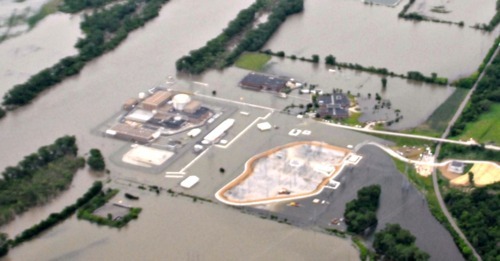
Operators shut down the reactor at the Fort Calhoun nuclear plant in Nebraska on April 9, 2011, for a scheduled refueling outage. The original plan called for the reactor to be restarted on May 29, 2011. But two floods washed out those plans.
The first flood occurred when the Missouri River overflowed its banks to make Fort Calhoun one of its islands (see figure above). For weeks, workers focused on keeping flood waters out of vital areas rather than resuming reactor operations.
When the waters receded, inspectors found a flood of safety and security problems that had been building up at the plant that conspired to keep it shut down.
As inspectors identified more problems, Fort Calhoun moved from the Licensee Response Column (Column I) to the Multiple/Repetitive Degraded Cornerstone Column (Column IV) of the Nuclear Regulatory Commission’s (NRC) Regulatory Oversight Process Action Matrix and then into the agency’s Manual Chapter 0350 process for troubled plants in prolonged outages. In other words, Fort Calhoun’s grades steadily dropped until it required the equivalent of a nuclear timeout.
Emergency preparedness shortcomings are among the many safety and security problems to be resolved before the NRC permits the restart of Fort Calhoun. For example, on June 7, 2011, an electrical breaker that had been recently replaced started a fire at the plant. Operators declared an “Alert” – the third most serious of the NRC’s four emergency classifications – due to the fire. The company was supposed to notify state and local officials within 15 minutes about the emergency declaration, but failed to do so.
In another case, the company communicated what’s called a Protection Action Recommendation – a recommendation for actions necessary to protect the public – to state and local officials during an emergency exercise, but later decided it was unnecessary and withdrew it. One can argue about whether false alarms are worse than no alarms, but neither adequately protects the public.
Fort Calhoun was still shut down on April 9, 2012, marking the 48th time since the Three Mile Island (TMI) Unit 2 meltdown in March 1979 that a U.S. reactor had to be shut down for a year or longer to restore safety levels to the minimum level required for safe operation. It is also the 48th time this has happened since the nuclear industry created the Institute for Nuclear Power Operations (INPO) in the wake of that accident.
INPO allegedly established standards of excellence that it allegedly measures reactors against. But a reactor shut down for more than a year because it fell below – and stayed below – NRC’s minimum safety standards must have fallen below INPO’s standards of excellence well before that. Did INPO not realize that safety levels dropped so far below its standards of excellence on these 48 occasions? Or did INPO notice but find itself incapable of doing anything about it?
INPO purportedly functions as an industry watchdog, aggressively monitoring safety performance at all plants to prevent another meltdown. Well, there hasn’t been another reactor meltdown since TMI, but there have been 48 financial meltdowns. Had INPO actually functioned as an industry watchdog and avoided the 48 massive performance declines that took armies of workers to undo, the associated cost savings could have been placed into an escrow account. The nuclear industry would not now need loan guarantees for new reactors. It could tap this escrow account and still have plenty of cash left over for a nuclear waste repository or two.
The nuclear industry pays considerable sums each year for INPO. The nuclear industry should consider paying a consultant to find out why INPO is just another four-letter word.
